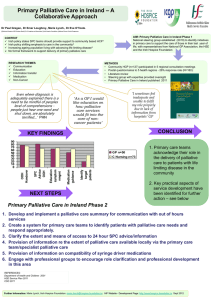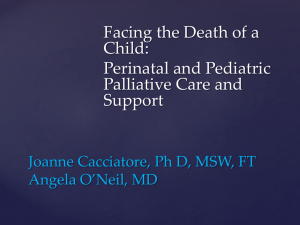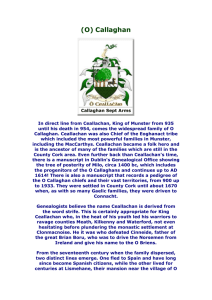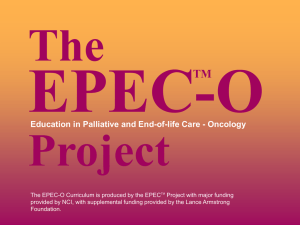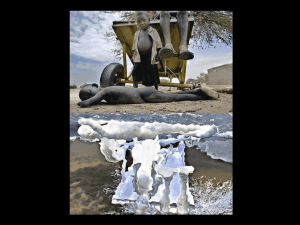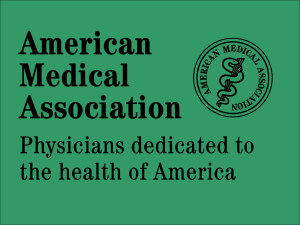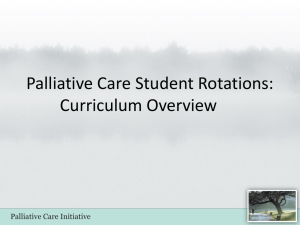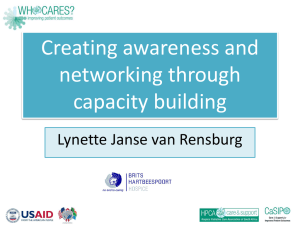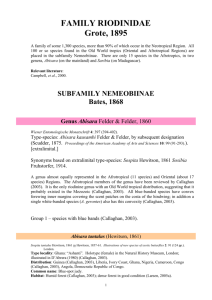music therapy
advertisement
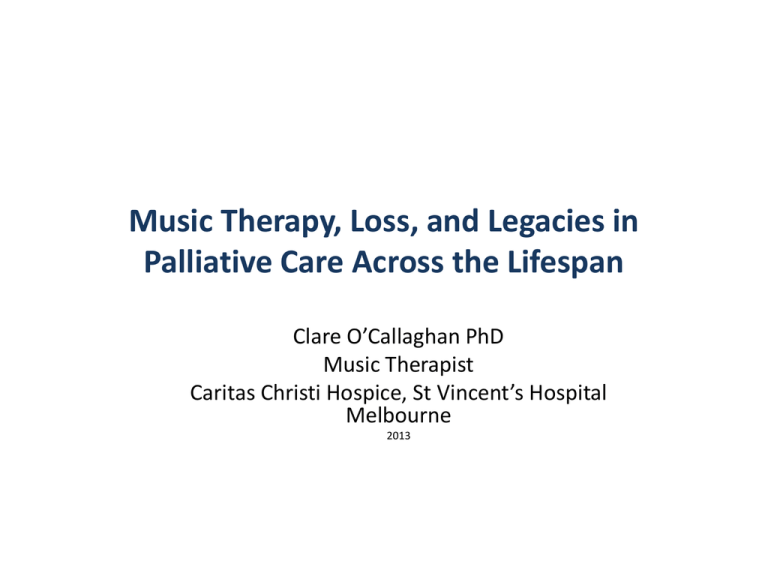
Music Therapy, Loss, and Legacies in Palliative Care Across the Lifespan Clare O’Callaghan PhD Music Therapist Caritas Christi Hospice, St Vincent’s Hospital Melbourne 2013 Aims • Music’s role in health and loss throughout the Ages • What music therapists do with patients and their families/close friends across the lifespan • Research that informs music therapy in palliative care • Ideas for appropriate and sensitive music use by multidisciplinary team members Music in Health Across the Ages 2000 BC: Egyptian papyri – disease treated with drug and music therapies Apollo: god of music and medicine David playing the harp to relieve Saul’s depression and anger St Luke: physician and first Christian hymnologist (Samuel 1, Ch 16) Middle Ages: Needed to be a Master of Music to study medicine at Padua University Operation Bell of 1791, Royal London Hospital: prior to the discovery of anesthetics, the Bell was rung before a surgical operation to summon attendants to hold the patient still. Pre-industrial societies - share “world views”; ritualised use of music for healing & dealing with loss (Laderman & Roseman, 1996) Shamans use song, poems, drums, dance and objects to elicit trance states to heal. (Vitebsky, 1995) The loss of music is a pivotal feature of health care within the “modern age” (Biesele & Davis-Floyd, 1996), although isolated reports existed. 1891: Music performances in London Hospitals; supported by Florence Nightingale. 1925: Music performances in 15 New York Hospitals (Edwards, 2007) Interest in music and artistic media to enable transformative and healing experiences, which may help individuals to prepare for death (Frohnmayer, 1994; Kearney, 1992) 1944: USA Music therapy training. Non prescriptive Now throughout the world: www.wfmt.info/WFMT/Home.html Australia: In1978, Music therapy training commenced as the University of Melbourne ) In Melbourne (2013), Music therapy is offered to all children with cancer and available in: Peter Mac, Royal Melbourne Hospital, Royal Children’s Hospital, Monash Children’s, & many inpatient and home-based hospice programs Another initiative: music thanatology, the prescriptive use of music (Schroeder-Sheker, 1993) Music Therapy in Palliative Care the creative and professionally informed use of music in a therapeutic relationship with people identified as needing physical, psychosocial, or spiritual help, or with people aspiring to experience further self-awareness, to enable increased life satisfaction and quality. (O’Callaghan, 2010) Following assessment, music therapists can offer methods: Replaying the Music of One’s Life Live performance Music listening Music and life review Word substitution in known songs Exploring ‘New’ Music (instrumental and computerized) Music improvisation Song writing Unfamiliar pre-composed music (recorded or live) Music and Imagery (with live or recorded music) Free association Guided NB. Music therapy is appropriate for anybody. You don’t don’t need a musical background. Cancer & Palliative Care Aims MT can Address: Adults 1. Supportive validation: feelings, thoughts; one’s self worth; living until dying Music choice reflects who and what we need to get in touch with We project into music and take from it what is needed Lyric identifications enable one to feel understood and part of a wider human experience Music’s sound qualities touches our emotion 27 yo Amy, the day before dying, requests ‘The Prayer’ Lead us to a place, guide us with your grace To a place where we'll be safe 2. Increased self-awareness to aid adaptation; self discovery 3. Symptom relief and relaxation Pain, tension, insomnia, dyspnoea, restlessness, nausea Preferred and low arousal music is most associated with relaxation response, and pain reduction (Sloboda, Lamont, & Greasley, 2009). Isoprincipal: musically matching a patient’s physical and emotional state, gradually shifting the musical elements to match the patient’s move into a more desired state. Music preferences may alter as illness progress 36 yo Erin: from contemporary popular to classical Theoretical rationales for pain reduction in MT Direct physiological response to music stimuli that alter neural components of pain sensation Cognitive and emotional changes aligned with increased self-awareness, thereby altering one’s sense of its meaning (O’Callaghan, Am J Hosp Pall Care, 1996) 4. Connection with others, reduced isolation: incl. cognitively impaired, language barriers; create intimate space Music and language activates more areas of preserved neural function, offering expanded opportunities for aesthetic experience and meaningful communication. (Levitin, 2006) 5. Spiritual connection Aesthetic experience: pleasure, “normalcy”, creativity, transcendence, community 6. Support expression of grief, bereavement: catharsis, reframe regret, self acceptance, moving forward Mother of daughter who died: Making that song, ‘Jo Jo the Jumping Frog’, and we made it in different (music therapy) sessions, they were looking forward to coming in (to hospice) … Every now and then (granddaughter) would say, ‘Remember Jo Jo the Jumping Frog.’ … It’s good times they can relate to … instead of saying, “Oh remember we went to this awful dungy place.” … Good times came out of that, some good feelings, not all sad. (O’Callaghan, McDermott, Hudson, Zalcberg, Death Stud, 2013) A good death is associated with making meaning of one’s life (Cassell, 1991; Kearney, Palliat Med, 1992) Legacies include physical items and memories which help to validate a life, and support adaptive and creative living until its mortal completion. (Coyle, J Pain, Symptom Manage, 2006) Legacies can assist the bereaved, through being a comforting connection with a loved person who has died. Legacies allow developmentally suitable messages. Music Therapy Legacy Work Music Therapy Preloss Care: intentional creation of opportunities with patients with life threatening conditions and/or their families that may enable the mourners’ improved bereavement experiences if the patient dies. Provided through memorable shared music therapy sessions and events, such as concerts. Also provided through helping patients to create tangible legacies, including: ~ Song compositions which may be recorded with special messages attached ~ Music-based life reviews (playlists of patients’ significant music, with possible textual or audio-visual recorded narratives). (O’Callaghan, Prog Pall Care, 2013) Why is preloss care important? Ways in which patients and their families are treated during the patients’ advanced illnesses influences bereaved people’s experiences: bad experiences apparently shape negative responses while good care is associated with more positive reactions. Reid D, Field D, Relf M. Adult bereavement in five English hospices: Participants, organisations and pre-bereavement support. Intern Jnl Pall Nurs 2006; 12(7): 320-327 17 Cancer inpatients song lyrics for their children O’Callaghan, O’Brien, Magill, Ballinger (2009) Support Care Cancer Song groups’ lyrics separately analyzed: 1. 19 songs by 12 patients in sessions with CO 2. 16 songs by 15 patients, available to public Inductive, comparative, and iterative thematic analysis, based on grounded theory (Corbin & Strauss, 2008): codes, categories, themes, final statement. Finally, the 2 final statements were comparatively analysed and merged into a … Final statement (abridged) Parents may convey their felt and enduring love and hopes for their children, and their metaphysical presence in their lives. While many grieve with their children, some also look forward to, or yearn for, a shared life together. Parents may associate their children with miracles and life’s wonder, and describe, encourage, and compliment their children’s qualities and lifespan experiences. Parents can also describe how they find their children’s many qualities helpful. While some parents apologize or request their children's optimism and forgiveness, many convey their personal reflections, including their existential and metaphysical beliefs … (such as) being present now and after life. Parents sometimes offer their children supportive strategies in the songs. Parents may write “playsongs” for young children to affirm, support, and encourage them. Why are such legacies important? • Inattention to parent-child interactions in hospice is “woeful” (Saldinger et al, Death Stud, 2004) • Parents need to communicate about advanced illness in developmentally appropriate and factual ways but there are few resources available to help (Turner et al, Palliat Support Care, 2007) • Through song writing parents are able to communicate what they want known in tolerable ways • Child hears s/he is in the parent’s mind and is loved. • This promotes development of a secure sense of self (Winnicott,1971) and adaptive bereavement (Raphael, 1984) Music Therapy with Young People with Cancer “Normal”, fun activity on own or to share with others Self-expression, mastery, empowerment, distraction from aversive stimuli, attachment promotion with parents Symptom relief: non pharmacological analgesic Methods: improvisation, music stories and play, songwriting, MTCD (software) creation, therapeutic music lessons, groupwork (song sharing; song writing) (e.g., Abad, Aust J Music Ther, 2003; Barry, O’Callaghan, Grocke, & Wheeler, J Music Ther, 2010, O’Callaghan, Sexton, & Wheeler, Austral Radiol, 2007) RESEARCH: Cochrane Review Bradt & Dileo (2010) Music Therapy in End-of-life Care Meta-analysis: quality of life section Well-being Analysis Mean Differences [95% CI] p-value Functional 13.4 [7.25-19.54] 0.02 Psychophysiological 17.41 [9.10-25.7] < 0.001 Social/spiritual 6.02 [1.67-10.37] < 0.001 Overall 0.69 [0.11-0.27]* 0.007 * Standardized Mean Difference = Mean Difference / SD Despite signifcant findings for music therapy improving the quality of life of the palliative care patients the authors concluded that there is “insufficient evidence of high quality to support the effect of music therapy on quality of life of people in end-of-life care” (Bradt & Dileo, 2010, p. 2) (One of the reasons is because) Cochrane guideline: findings from any non-blinded research potentially has a “high bias risk.” (Higgins & Green, 2008, p. 199) Effect of Music Therapy on Staff Bystanders O’Callaghan & Magill (2009) Palliat & Support Care 1. Peter Mac data analysis: Anonymous text feedback N = 39 2. MSKCC data analysis: Interview feedback N = 61 3. Further comparative analysis: grounded theory about music therapy’s effect on oncology staff Grounded Theory Cancer research hospital staff often benefit from witnessing, and occasionally engaging in, patient/visitor centred music therapy sessions; intrusive effects on staff work life are uncommon. Music therapy can elicit in staff a range of personally helpful emotions, mood states, and selfawarenesses …. Staff believe that these factors, and the improved, more humane work environment, can also enhance their care of patients and teamwork. Music Therapists can help to Promote Positive music Environments in Clinical Settings For example, some staff in a cancer hospital questioned whether a Staff Christmas Choir was inappropriate in a context with people from varied cultural backgrounds. So the music therapist led a research project asking: What is the relevance of the Oncology Staff Christmas Choir for patients, visitors, and staff? (O’Callaghan, Hornby, Ball, Pearson, Med J Aust, 2009; J Palliat Med, 2010) Method: Convenience sampling … invited to complete anonymous and open- ended questionnaires after seven Choir performances. Purposeful sampling: early departing bystanders were invited to participate. Inductive and comparative data analysis was informed by grounded theory, and qualitative inter-rater reliability was performed Findings: Questionnaires from 179 people returned The Choir transcended religious and cultural boundaries, eliciting positive emotions and memories amongst many patients, visitors and staff … described transformative thoughts and physical reactions, being affirmed of the Christmas spirit or message, welcoming the enlivened and social atmosphere. Staff particularly mentioned how the Choir united and promoted patient and team wellbeing, and most choir members reported that participation improved their work-life. Adverse effects were rare (3 patients; one staff). (The choir continued) Ideas for Sensitive Music Use PATIENT CHOICE is imperative for relaxation response (Stratton & Zalinowski, J Music Ther, 1984). Nb. type of music; volume; time and place Suggest music usage: bring ipods/Cds from home for procedures, inpatient stays Suggest patients thoughtfully consider using favorite music for aversive procedures as associated effects may contaminate future enjoyment. Encourage “normal” family usage as appropriate. eg, Parents play children’s music CDs during visits; families can bring instruments to play; couples share favorites Encourage music libraries with diverse music choice and instrument availability in clinical settings that patients/families can access. Perhaps include CD “samplers”. Ensure patients can control volume and turn off ; regularly offer to help music access to those physically disabled Suggest patients’ families/friends to give or make special CDs as gifts Musical life review CDs and stories can be fun to create and affirming Talk to patients about their music interests which indicates interest in the ‘person’ rather than the patient Consider financial support/ grants to help patients get access music I’d rather the money to see my favorite band instead of a free wig (adolescent) Consider live concerts or background music sensitively. Areas where people can come and go from are good (eg., foyers). When patient has brain impaired (eg, adynamic; memory loss) regularly offer music. NB. Listening to the same music repetitively is ok if its enjoyed If people appear “upset” listening this may be ok, especially if they have requested the music. Consider whether to inquire about the emotion and offer support or leave them to contemplatively be If patient or family is concerned about their music reaction (e.g., emotional response; changes in preferences; loss of music interest) perhaps reassure that varied responses to music can be normal when one has cancer Consider the potential effects of your personal music usage on the wards on overhearing patients and staff Adverse Effects Minimal with choice. Careful with overhearers when music in open contexts. What helps someone can trigger discomfort in another. Watch how neural lesions may affect music perception (distortion, pain) Musicogenic epilepsy; musically induced catastrophic reactions (rare) We need and spontaneously turn to music to carry mourning too heavy for words and preaching …. to gather strength and patience to wait assurances, stronger than hope, should they ever come, assurances that all indeed is never lost, that some blessings are unburiable. R. D. Roy, Editor, Journal of Palliative Care, 2001. References Abad,V. (2003). A time of turmoil: music therapy interventions for adolescents in a paediatric oncology ward. Aust J Music Ther, 14, 38–39. Barry, P., O’Callaghan, C., Grocke, D., & Wheeler, G. (2010). Music therapy CD creation for initial pediatric radiation therapy: A mixed methods analysis. Journal of Music Therapy, 48(3), 233-263. Biesele, M., & Davis-Floyd, R. (1996). Dying as a medical performance: The oncologist as charon. In C. Laderman & M. Roseman (Eds.), The performance of healing. (pp. 291-322). New York: Routledge. Bradt, J., Dileo, C., Grocke, D., & Magill, L. (2011). Music interventions for improving psychological and physical outcomes in cancer patients :DOI: 10.1002/14651858.CD006911.pub2. Edwards , .J. (Ed.) (2007). Music: Promoting health and creating community in healthcare contexts. Newcastle: Cambridge Scholars Publishing. Frohnmayer, J. (1994). Music and spirituality: Defining the human condition. International Journal of Arts in Medicine, 3, 26-29. Kearney, M. (1992). Palliative medicine - Just another specialty? Palliative Medicine, 6, 39-46. Laderman, C., & Roseman, M. (Eds.). (1996). The performance of healing. New York: Routledge Levitin, D.J. (2006). This is your brain on music. London: Atlantic. O'Callaghan, C. (1996). Pain, music creativity and music therapy in palliative care. Amer J Hosp Pall Care, 13(2), 43-49. O'Callaghan, C. (2010). The contribution of music therapy to palliative medicine. In G. Hanks, N. Cherny, N. Christakis, M. Fallon, S. Kaasa & R. Portenoy (Eds.), The Oxford Textbook of Palliative Medicine (4th ed.) (pp. 214-221). Oxford: Oxford University Press. O'Callaghan, C. (2013). Music therapy preloss care though legacy creation. Progress in Palliative Care, 21, 78-82. O'Callaghan, C., Hornby, C., Pearson, E., & Ball, D. (2009). "The moment is all we have": patients and visitors reflect on a staff Christmas choir. Medical Journal of Australia, 191(11/12), 684-687. O’Callaghan, C., Hornby, C., Pearson, E., & Ball, D. (2010). Oncology staff reflections about a 52- year-old Staff Christmas Choir: Constructivist research. Journal of Palliative Medicine. 11(12), 1421-1425. O’Callaghan, C., McDermott, F., Hudson, P., & Zalcberg, J. (2013). Sound continuing bonds with the deceased: The relevance of music, including preloss music therapy, for eight bereaved caregivers. Death Studies, 37, 101-125. References (cont) O'Callaghan, C., & Magill, L. (2009). Effect of music therapy on oncologic staff bystanders: A substantive grounded theory. Journal of Palliative and Supportive Care, 7(2), 219-228. O’Callaghan, C., O’Brien, E., Magill, L., & Ballinger, E. (2009). Resounding attachment: Cancer inpatients’ song lyrics for their children in music therapy. Supportive Care in Cancer, 17(9), 1149-57. O’Callaghan, C., Hornby, C., Pearson, E., & Ball, D. (2010). Oncology staff reflections about a 52- year-old Staff Christmas Choir: Constructivist research. Journal of Palliative Medicine. 11(12), 1421-1425. O’Callaghan, C., McDermott, F., Hudson, P., & Zalcberg, J. (2013). Sound continuing bonds with the deceased: The relevance of music, including preloss music therapy, for eight bereaved caregivers. Death Studies, 37, 101-125. O'Callaghan, C., & Magill, L. (2009). Effect of music therapy on oncologic staff bystanders: A substantive grounded theory. Journal of Palliative and Supportive Care, 7(2), 219-228. O’Callaghan, C., O’Brien, E., Magill, L., & Ballinger, E. (2009). Resounding attachment: Cancer inpatients’ song lyrics for their children in music therapy. Supportive Care in Cancer, 17(9), 1149-57. Raphael, B. 1984. The anatomy of bereavement, Melbourne, Hutchinson & Co Ltd. Reid, D., Field, D., & Relf, M. (2006). Adult bereavement in five English hospices: Participants, organisations and pre-bereavement support. Int J Palliat Nurs, 12(7), 320-327. Roy, D.J. (2001). That all not be lost. Journal of Palliative Care, 17, 131-132 Saldinger, A., Cain, A., Porterfield, K. and Lohnes, K. (2004). Facilitating attachment between school-aged children and a dying parent. Death Studies, 28, 915-940 Schroeder-Sheker, T. (1993). Music for the dying: A personal account of the new field of music thanatology - History, theories, and clinical narratives. Advances, The Journal of Mind-Body Health, 9(1), 36-48. Turner, J., Yates, P., Hargraves ,M., Hausmann, S. (2007). Development of a resource for parents with advanced cancer: What do parents want? Palliative and Supportive Care, 5,135-145. Vitebsky, P. (1995). The shaman: Voyages of the soul, trance, ecstasy and healing from Siberia to the Amazon. London: MacMillan. Winnicott, D.W. (1971). Playing and reality. London: Routledge.
